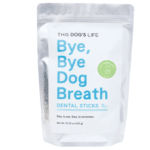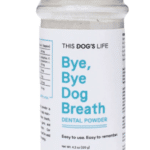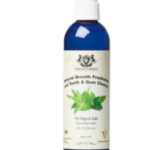Scrolling through Facebook last night, I saw a post on a pet site; someone was asking, “How do I get rid of stinky dog breath?” A lot of people responded, of course, with all the methods that everyone uses, and lots of options I’ve used in the past. Some have worked, some, are very temporary.
Many people turn to things like Greenies, or other treats that can help, others use brushing as a method, some use the latest additive that you can add to your pets water or food, and some just use the vet and get a cleaning done. So what really works?
Treats That Can Help Alleviate Stinky Breath.

Many people have turned to using treats as a way to alleviate their dog’s stinky breath. There are treats out there like Greenies that can be used, or even other treats that contain mint as part of their ingredients. Some pet toy manufacturing companies have made toys that have rubber sticking out in all kinds of odd ways that claim that it helps clean teeth as they chew.
I’ve used several of the above options for my dogs in the past. Greenies do tend to work well and you can usually tell a difference within a few treats. The only hard part with Greenies are, not all dogs like them. I’ve had several dogs that once they reach maturity, if I hadn’t given them Greenies as pups, they turn their nose up at them. Same with the other treats that contain mint as an additive.
Greenies are, not all dogs like them. I’ve had several dogs that once they reach maturity, if I hadn’t given them Greenies as pups, they turn their nose up at them. Same with the other treats that contain mint as an additive.
The rubber Kong toys that have odd rubber pieces can help, but my dog usually loses interest with them over a period of time, especially after they figure out the toy just rubs their gums. They usually go for the fluffy toys, or the bones after a short while.
I will say, I’ve added the dog toothpaste to the Kong toys in the past, and that usually peaks my dogs interest again. Just be sure you don’t have carpet, cause it makes a mess. Best do it in the bathroom if that’s the case.
Additives In Food Or Water.
 There are lots of additives out there that you can add to your dog’s water bowls, food or even treats that will help eliminate dog breath. I tried the one that you add to the food and it actually worked pretty decently. All my dogs ate from the food bowl, and most of them had better breath within a couple of days. The exception, my oldest dog that was 14 at the time (this was only a couple of months ago), her breath was so bad at 14 that nothing worked.
There are lots of additives out there that you can add to your dog’s water bowls, food or even treats that will help eliminate dog breath. I tried the one that you add to the food and it actually worked pretty decently. All my dogs ate from the food bowl, and most of them had better breath within a couple of days. The exception, my oldest dog that was 14 at the time (this was only a couple of months ago), her breath was so bad at 14 that nothing worked.
If you have an elderly dog with very bad breath, your only saving grace may be to see a vet for a thorough cleaning. Just be prepared to spend a small fortune because at that age, they usually don’t like their teeth cleaned.
It’s best to start dogs off with these additives at a younger age. If you keep up with it, they really do work and you’ll notice that their breath gets better within a few short days.
Breath Fresheners.
 You might be wondering at this one – breath fresheners? Like air fresheners? Kind of. More like Binaca that I’m sure most of you know about. Comes in a tiny little bottle that you simply spray in your mouth and voila, better breath instantly! They have these for dogs too.
You might be wondering at this one – breath fresheners? Like air fresheners? Kind of. More like Binaca that I’m sure most of you know about. Comes in a tiny little bottle that you simply spray in your mouth and voila, better breath instantly! They have these for dogs too.
They’re a natural option for dogs bad breath. You simply spray it in their mouth, and Bam! Better breath. Should this be used solely for their bad breath though? No. Honestly, the best way to fight bad breath is the same for dogs as it is for humans, brushing is the clear way to get your dogs breath to stay fresh.
Toothbrush Options.
Brushing your dogs teeth can seem like a daunting task, especially if you have an older dog and you’ve never tried this before. I’m here to tell you, brushing your dogs teeth should be a grooming  ritual you start when they’re pups. If you take a 4 or 5 year old dog and all of a sudden, you want them to hold still for you while you dig around in an attempt to brush their teeth, well, you’ll get the head turn, then eventually, the full on, “I’m running away now.”
ritual you start when they’re pups. If you take a 4 or 5 year old dog and all of a sudden, you want them to hold still for you while you dig around in an attempt to brush their teeth, well, you’ll get the head turn, then eventually, the full on, “I’m running away now.”
This is the best, and the most surefire way to be sure your dog doesn’t have bad breath. Start them young if you can. If they’re older, get a partner to help you hold them still or put them on a leash where they can’t run. The toothpaste that comes with the kits you can buy is usually a chicken flavor or peanut butter flavor (I’ve never tried it to see if it really tastes like peanut butter), so dogs will usually enjoy it.
But if your dog really has stinky breath, then you should be brushing their teeth. It’s the same with humans. When you go to a dentist and ask how to get rid of bad breath, your dentist is going to ask you how many times a day you brush. If you say none, they’re going to say, well, brush your teeth.
All The Above Methods Are Good.
If you’re brushing, using breath fresheners, treats sporadically, and the dental additives, I can pretty much guarantee your dog does not have bad breath. There’s no one way is the only way method. Brushing is the most important, but in between that, the other options are great options. If you’re only going to use one, get the toothbrush kit. I have it, I use it on my dogs (they each have their own) and honestly, it works wonders. Click here for the best toothbrush kit on sale today.
My youngest female dog gets bad breath when she’s about to go into her heat cycle (click here for my article on that), so I do use the other options for her specifically, because her breath smells like copper during those periods of time. For Greenies, Buy them here with my personal coupon, 15% off!
For the other dental chews, buy them here!
Additives
As for the additives, I use that as well, but I use it sparingly. I try to focus more on the tooth brushing, but it does help with my older chihuahua’s who give me a very rough time brushing their teeth, so the powder helps immensely for them. Buy the additive here. If you want the kit that comes with the chews and the powder to save money with my link, then buy it here.
Lastly, the spray. If you want Binaca for your dog (obviously the dog friendly kind) for when they have some retched breath and you need something quick, then buy it here with my coupon.
All these options are great, they work well and they work wonders. Each dog owner is different in what they use for their dogs and each option has a different price tag. Some are actually very inexpensive, like the toothbrush kit, and others are a little more, like the food additives. But trying what works and what your dog will tolerate will help you in the long run. Especially when they come in for kisses and you welcome them with open arms because their slobber is tolerable and even minty fresh!
What method do you use at home currently?

Hi Katrina, Great info on the different ways to help with dog’s stinky breath. I have 4 (Mastiff, 2 Boston Terriers, and a Shorkie) and live on a small acreage. All live somewhat peacefully in the house but I let them run outside and sometimes they find some really disgusting things to eat and roll on. None pay any attention to Greenies and all but the Shorkie are older, the toothbrush won’t be of much use with them! But the breath spray, now that is an option. Thanks for the tips!
Hi Sanders,
Yes, lots of options out there for all dogs. Brushing can be really hard for older dogs, they tend to want to run away and give you the stink eye! I definitely know what you mean when it comes to dogs rolling around and eating gross stuff. I know that dogs like to rub their scent on things, especially things they find as a food source. It’s natural for them to “mark their scent” on something that could be food for them.
The spray is a good option though and at least it’s quick, so no holding down!
Hope it helps!
Katrina
How to get rid of stinky dog breath is a common problem I hear dog owners complain about, but I have never had that problem with my dogs. I do have my dogs on a natural diet with none of those dog foods on the market today, I also provide my dogs lots of natural treats such as veggies and fruit instead of doggy snacks. Not sure if that has anything to do with stinky dog breath or not, but we all know the dog foods are not the best smelling products on the market.
Jeff
Hi Jeff,
Yes – 99% of dog foods contain harmful chemicals as well as bad meat products. I’m not sure if you saw my article on the food products out there, but here’s a link for you if you’re interested. https://katrinaspetapparel.com/dog-food-how-to-know-good-vs-bad/
After conducting days of research, I found out that the food I was feeding my dogs was one of the bad ones. I’ve been doing testing since writing that article on my dogs – not in a bad way, but giving them the foods that after thorough research, are good for them. But in the testing, I’m logging which foods they actually want to eat versus the ones that they just nibble at. Unfortunately, the Wellness Core RawRev chicken based, healthy grains for adult dogs is not their favorite.
So, I took a bunch of salmon from my freezer, baked it, ensured all bones were removed and I add that with some brown rice and vegetables and give them that for dinners. I also give them raw carrots for treats and that seems to help with the bad breath for the most part.
My youngest female still gets very stinky breath near her heat cycle, but that’s the hormones in her system that cause her breath to smell like copper I’m sure.
Katrina
I know that it is not possible to force a dog to drink more water than they are comfortable with – but do you know if there is a link between hydration and the bad breath aroma?
Hi Simon,
Dehydration would lead to bad breath since they’re not salivating as much as they should. Dogs sweat from their mouth as well, so lack of water could lead to further dehydration if there isn’t enough water in their system to allow them to sweat.
Some dogs won’t drink from a stagnant source of water – if your dog hates the water bowl, you might want to look into an outdoor water fountain; they may want a running source of water versus the bowl.
I’ve also noticed some dogs don’t like the plastic bowls that make up the majority of dog water bowls, but it’s because the plastic will hold onto the bacteria from their mouth and it gets coated in a slimy substance and makes the water taste bad to them. I have 3 water sources for my 3 dogs; my littlest female Chihuahua will not drink from the main water bowl which is plastic and an auto-water bowl and holds 3 gallons of water. Over the course of the winter, I didn’t realize she wasn’t drinking from this until she had a small seizure and I realized it was from dehydration after keeping an eye on her for a few days. After grabbing a small glass bowl and trying that, she drank 3 bowls within 5 minutes. Now, she gets her own small, glass water bowl that I fill daily.
My youngest female also only drinks from the outdoor water fountain because it’s a running source of water. In the winter, I’ll most likely have to invest in the indoor fountain for dogs that you hook up directly to a water pipe for her to keep her hydrated.
My male Chihuahua is the only one that will drink from the indoor plastic water bowl.
Dogs, like us, prefer their water source to be tasty to them. Some of us like room temp water, other’s ice cold, and some only from a bottle. Trying different methods with your dog should help them to drink more. Maybe, even to try the running source, turn on a water hose to a very minimal water spray and see if they drink from that. That should tell you if they want fresh water and from a source that’s running.
Hope this helps and hopefully you find a way for your dog to drink more. Dehydration in dogs can lead to a lot of complications down the road, bad breath being just the start of it.
Katrina
Thank you for the links to the products, I can’t wait to receive mine!
Glad these tips worked for you! As I continue to learn new products, I’ll be sure to pass that info along!
Katrina
TOTALLY FABULOUS WEBSITE !
Love your work.
Thank you! I’ve definitely been building this for anyone to have some answers for their pets. 🙂
Katrina